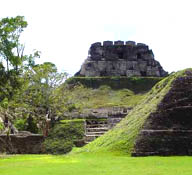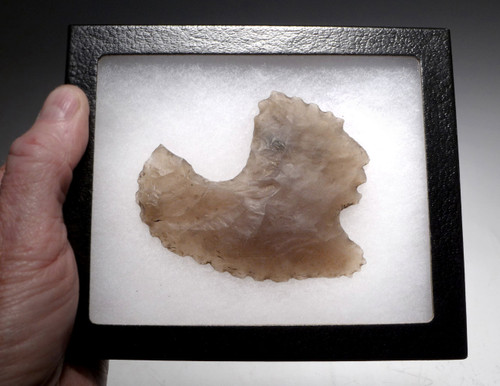Product Description
SEE MORE PRE-COLUMBIAN ARTIFACTS
This is an EXTREMELY RARE flaked Mayan flint chert eccentric effigy of a Mayan shaman priest in a ritual where they are undergoing their shape-shifting powers, as a Nagual. In Mesoamerican folk religion, a nagual, or nahual (both from the Nahuatl word nāhualli), is a human being who has the power to shapeshift into their tonal animal counterpart. Nagualism is tied to the belief one can access power and spiritual insight by connecting with the tonal animal within. The system is linked with the Mesoamerican calendrical system, used for divination rituals. The practice of Nagualism was often accompanied by use of hallucinogens, including peyote, ololiuqui, and psylocibin mushrooms known as teonanácatl. Use of these medicinal herbs were said to unlock powers of perception and insight in those performing the nagual rituals.
The Mayan figure shows amazing features, expertly flaked out of stone that required extreme skill in controlling the knapping and avoiding any breakage. The inlet regions demonstrate the most difficult achievement of a master flintknapper! The figure shows a human shaman priest that is changing into what appears to be a centipede. Symbolically, the centipede was thought to represent a channel between the realms of the living and the undead. This connection was likely made as centipedes often reside in dark, wet places like caves, which are considered to be liminal entrances to the underground realm by Mayan culture. The centipede's activity during night, and subsequent burrowing during the day, marked a transition between the two boundaries.
The workmanship and detail is so exquisite, it is obvious the stoneknapper artisan of this unusual ceremonial object was of the highest skill level. Ample ancient deposits are intact on and in all micro-crevices and flaking hinge fractures of this specimen - traits ONLY seen in authentic, unaltered examples. From the famous Dr. Medina Pre-Columbian collection of which documentation will be provided to the buyer.
While we have handled thousands of exceptional Pre-Columbian antiquities, Mayan flint eccentrics featuring humans, are so rare, only a few specimens have passed through our hands. The rarity of these human eccentrics have made them 'Holy Grails' in museum collections of Mayan objects of art. Mayan eccentric flints show a great variety of forms, such as crescents, crosses, snakes, and scorpions. Rarer forms display human features. The largest and most elaborate ones display multiple human heads, with minor heads sometimes branching off from larger ones. The human face is youthful and crafted as a simple outline, with emphasis on the sloping forehead and the lips. Human faces are commonly regarded as transformations of the lightning deity, god K (K'awiil). Eccentric flints representing the lightning deity himself are also found, though with less frequency, while some eccentric flints combine both human and God K faces.
No one knows what these eccentric figures mean in the Mayan Culture but both individual, as well as caches of them have been excavated from numerous sites. They are usually made of flint, chert or obsidian. Some resemble recognizable objects while others are extremely abstract. The value of these Mayan knapped eccentrics is based on the workmanship, symmetry and difficulty in the flaking of the design. Some of the most complex examples with human forms have fetched six-figure prices in major auctions recently!
As always with any ancient knapped stone, one must look for mineral deposits and encrustations deep in the microscopic flake scars of the knapped surfaces to ascertain authenticity. This exceptional specimen has these intact deposits as seen in the photos. Forgeries will not!
HISTORY
 Of all the ancient cultures of the Americas, no civilization has held more intrigue and secrets for so long as that of the Mayans. In 1960, their language code of glyphs was finally deciphered and forever changed our view of what we initially thought was a peaceful and harmonious society. On the contrary, the Mayan Culture of the latter years was bathed in the blood of vicious warfare and astounding levels of human sacrifice. Their technology was so advanced it is no wonder many believe they received intelligence from extra-terrestrials. Despite our recent discoveries of Mayan mathematics, astronomy and calendar technology, the Mayans still leave us with many mysteries. Their love of war caused them to manufacture spectacular weapons with inherent beauty and artistry. Their ceramics depict a fascinating culture of status, sacrifice and deep religious devotion to a number of strange gods.
Of all the ancient cultures of the Americas, no civilization has held more intrigue and secrets for so long as that of the Mayans. In 1960, their language code of glyphs was finally deciphered and forever changed our view of what we initially thought was a peaceful and harmonious society. On the contrary, the Mayan Culture of the latter years was bathed in the blood of vicious warfare and astounding levels of human sacrifice. Their technology was so advanced it is no wonder many believe they received intelligence from extra-terrestrials. Despite our recent discoveries of Mayan mathematics, astronomy and calendar technology, the Mayans still leave us with many mysteries. Their love of war caused them to manufacture spectacular weapons with inherent beauty and artistry. Their ceramics depict a fascinating culture of status, sacrifice and deep religious devotion to a number of strange gods.
Archaeologists divide the Mayan Culture into different periods - LATE PRE-CLASSIC / PROTO-CLASSIC (300 BC - 300 AD), EARLY CLASSIC (300 AD - 600 AD), LATE CLASSIC (600 AD - 830 AD), TERMINAL CLASSIC (830 AD - 950 AD). The earliest days of the Maya date back to 2000 BC when small farming villages first appeared in the highlands and Pacific coastline of Guatemala. Crops such as corn, squash and beans made up the staple of their diet and are believed to have been brought from previous migration through Mexico. The Maya pottery styles were unique to the early Maya settlements, though. By 1000 BC, villages sprang up in the lowland regions. The Maya lived in the same locations for centuries and in a continuous state of architectural improvement and expansion leading up to the magnificent 'super-cities' we associate with them today. By 300 AD. full-scale cities were being built with stone featuring massive plazas, temples and pyramids reaching 20 stories high.
It is no wonder that some believe that extra-terrestrial beings brought their knowledge to the Maya. By 300 AD, the first inscriptions suddenly appeared in Maya sites. These early inscriptions were so beautiful it was as if the gods had delivered it to the Mayan themselves! Forward to 600 years later and the inscriptions cease. The first comprehensive writing system in Pre-Columbian America was invented by the Maya. Among the mysteries of the Maya are their amazing understanding of astronomy along with the development of an accurate calendar and mathematical system. Their number system was based on units of 20 and included a concept of 'zero'.
The skills of the Mayan craft are exemplified in their stone and wood carvings, flaked stone objects, pottery and personal adornment. Much of their art centers around their devotion to a religion that is both fascinating and gory. Blood-letting rituals were the norm and many acts of war were motivated by the capture of vast numbers of their enemies for ritual human sacrifice that would run for days on end, forming lakes of blood and fat at the bases of their stone pyramids that defy architectural explanation.
Our understanding of the fascinating MAYAN CULTURE was completely wrong and misinterpreted until as recent as the 1960, when major achievements were made in the deciphering of their glyph language. Elaborately designed ceremonial cities lacking any obvious defenses initially led us to believe that the Mayans were a peaceful theocracy living in ideal harmony with their environment and each other. We could not have been further from the truth. Lowland city-states lived in constant warfare with one another and the thirst of their gods for human blood and sacrifice seemed impossible to satiate.
Perhaps a lesson for us today, recent scientific analysis of the demise of the highly advanced Mayan civilization now answers the biggest mystery of all - "What ever happened to the ancient Mayans?". Long-term high population density (500 people per square mile - the highest in the world at the time) of unbelievable proportions put a strain on their agricultural system that was impossible to sustain. The effects of nutritional deficiencies are evident in bone and tooth analysis on graves dating to the Late Classic Period. It is most probable that starvation put unbearable sociopolitical stress on the society to either kill each other for food or die of hunger necessitated by the technological advancement of warfare and its escalation.
 US DOLLAR
US DOLLAR
 EURO
EURO
 AUSTRALIAN DOLLAR
AUSTRALIAN DOLLAR
 CANADIAN DOLLAR
CANADIAN DOLLAR
 POUND STERLING
POUND STERLING


























